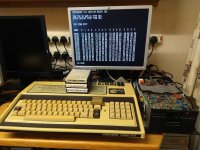I acquired an Exidy Sorcerer with Liveport FDM 180 and several ROM PACs some time ago but it was DOA.
Recently I found some time to look at it and managed to get it working after replacing 8 chips (one DRAM, four 2114 SRAMs, one TTL and two ROMS) plus one of the rectifier diodes failed while I was working on it.

(I've added an Exidy Sorcerer profile to the latest release of RGBtoHDMI)
I'm now looking at the Liveport FDM 180 drive but there seems to be very little info on that device.
The only references I could find to that are on here and a similar thread on stardot, both started by JonB:
Initially the Liveport blew a tantalum capacitor on first power up but after replacing that and using deoxit on all the connectors I managed to view the boot ROM at 0xDC00 and it looks like it matches the known good image posted by exidyboy in the above thread.
When trying to run the boot ROM using GO DC00 the drive light comes on and the head loads which seems to indicate that it might actually work.
However I don't have any floppy disks for it so I'm stuck for the moment.
A few questions for anyone that might be able to help:
When I first opened up the Liveport, all the DIP switches were set to OFF which I think would have put the boot ROM at 0x0C00 which is in the RAM area so I set it to the same as JonB's one in the above thread (i.e. SW3 and SW8 set to ON)
With this setting the Sorcerer hangs on bootup but when I set SW8 to OFF I could read the ROM and start it as above so does anyone have any info on the DIP switch settings?
The drive is a Micropolis 1015-2
When a floppy disk is inserted, the drive spins continuously. Is this expected behaviour?
Also the door latch is not working properly so are there any tips on repairing that?
I understand this drive is 100TPI rather than the standard 96TPI so I won't be able to create a disk from an image using another drive and would have to create a disk from an image using this drive. Is that correct?
Is this hard sectored or soft sectored?
If it's hard sectored do any of the imaging systems like kryoflux or greaseweazle work with that?
Are there any boot images available for this system and can any of the drive emulators (Flash floppy or HXC) be used in place of this drive for initial testing?
(I see there are standard Exidy boot images but would they work with this system?)
I have contacted JonB but he sold his system some time ago.
Recently I found some time to look at it and managed to get it working after replacing 8 chips (one DRAM, four 2114 SRAMs, one TTL and two ROMS) plus one of the rectifier diodes failed while I was working on it.

(I've added an Exidy Sorcerer profile to the latest release of RGBtoHDMI)
I'm now looking at the Liveport FDM 180 drive but there seems to be very little info on that device.
The only references I could find to that are on here and a similar thread on stardot, both started by JonB:
Initially the Liveport blew a tantalum capacitor on first power up but after replacing that and using deoxit on all the connectors I managed to view the boot ROM at 0xDC00 and it looks like it matches the known good image posted by exidyboy in the above thread.
When trying to run the boot ROM using GO DC00 the drive light comes on and the head loads which seems to indicate that it might actually work.
However I don't have any floppy disks for it so I'm stuck for the moment.
A few questions for anyone that might be able to help:
When I first opened up the Liveport, all the DIP switches were set to OFF which I think would have put the boot ROM at 0x0C00 which is in the RAM area so I set it to the same as JonB's one in the above thread (i.e. SW3 and SW8 set to ON)
With this setting the Sorcerer hangs on bootup but when I set SW8 to OFF I could read the ROM and start it as above so does anyone have any info on the DIP switch settings?
The drive is a Micropolis 1015-2
When a floppy disk is inserted, the drive spins continuously. Is this expected behaviour?
Also the door latch is not working properly so are there any tips on repairing that?
I understand this drive is 100TPI rather than the standard 96TPI so I won't be able to create a disk from an image using another drive and would have to create a disk from an image using this drive. Is that correct?
Is this hard sectored or soft sectored?
If it's hard sectored do any of the imaging systems like kryoflux or greaseweazle work with that?
Are there any boot images available for this system and can any of the drive emulators (Flash floppy or HXC) be used in place of this drive for initial testing?
(I see there are standard Exidy boot images but would they work with this system?)
I have contacted JonB but he sold his system some time ago.
Last edited:



